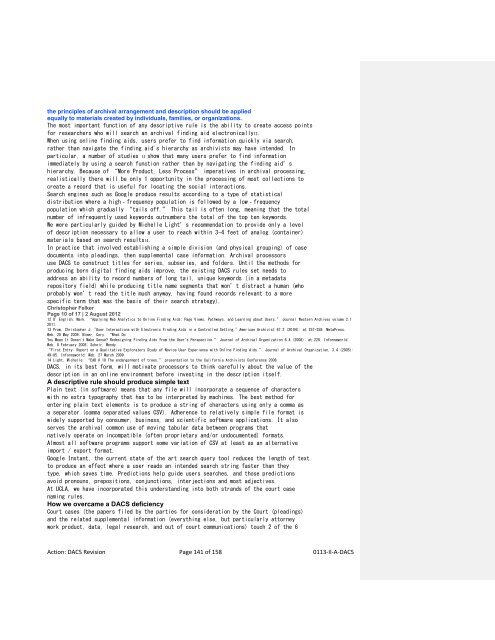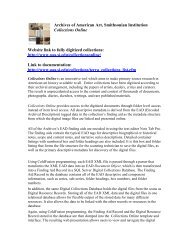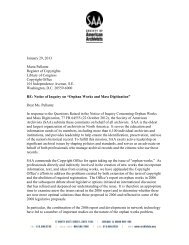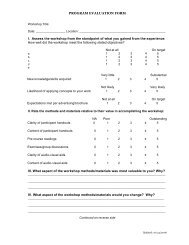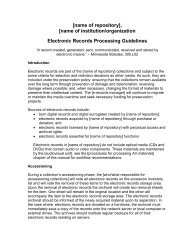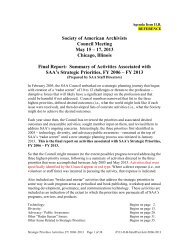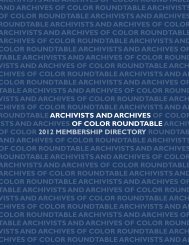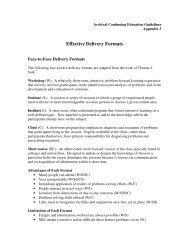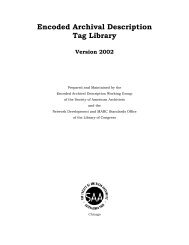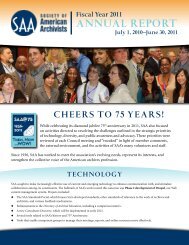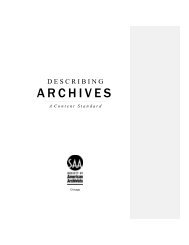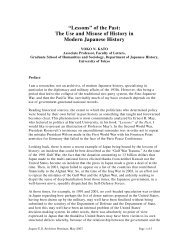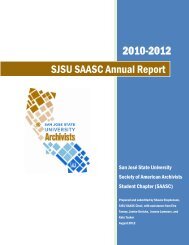- Page 1 and 2:
Agenda Item II.A.Society of America
- Page 3 and 4:
APPENDIX A: Full text of revisionD
- Page 5 and 6:
ContentsPrefaceAcknowledgementsStat
- Page 7 and 8:
PrefaceDescribing Archives: A Conte
- Page 9 and 10:
Finally, the subcommittee considers
- Page 11 and 12:
DACS 2013 DACS 2004Minimum, Optimum
- Page 14 and 15:
Statement of PrinciplesThe followin
- Page 16 and 17:
serves to identify archival materia
- Page 18 and 19:
which the descriptive system is ent
- Page 20 and 21:
Overview of Archival DescriptionThe
- Page 22 and 23:
Access points fall into six broad c
- Page 24 and 25:
created. Examples of such concepts
- Page 27:
PART IDescribing Archival Materials
- Page 30 and 31:
documents and other acquisition rec
- Page 32 and 33:
CHAPTER 1Levels of DescriptionArchi
- Page 34 and 35:
Requirements for Single-level Descr
- Page 36 and 37:
Multilevel RequiredThe top level of
- Page 38 and 39:
12 DESCRIBING ARCHIVES: A CONTENT S
- Page 40 and 41:
General Rules2.1.2. Record a refere
- Page 42 and 43:
2.2 Name and Location of Repository
- Page 44 and 45:
2.3.3. When devising title informat
- Page 46 and 47:
Paul Hibbet Clyde and Mary Kestler
- Page 48 and 49:
Coalition to Stop Trident recordsSt
- Page 50 and 51:
2.4 Date Element (Required)Purpose
- Page 52 and 53:
2.4.8. When further accruals are ex
- Page 54 and 55:
No dates2.4.16. When recording date
- Page 56 and 57:
General Rules2.5.3. Record the nume
- Page 58 and 59:
approximately 275 digital image and
- Page 60 and 61:
Commentary: When describing the rec
- Page 62 and 63:
Item title: Biography of Gardiner G
- Page 64 and 65:
2.7.5. Where the administrative/bio
- Page 66 and 67:
1886 Born 14 October, Fayetteville,
- Page 68 and 69:
lessons in voice and piano at Weste
- Page 70 and 71:
of the Texas Commission on Interrac
- Page 72 and 73:
long-range planning effort for capi
- Page 74 and 75:
Other Significant Information2.7.33
- Page 76 and 77:
Exclusions3.1.1. Record information
- Page 78 and 79:
File contains telex printouts of al
- Page 80 and 81:
Subseries 5, Alden Stevens, 1941-19
- Page 82 and 83:
the period of closure or the date w
- Page 84 and 85:
The audio cassettes are located in
- Page 86 and 87:
The Personnel Master File contains
- Page 88 and 89:
archives preserving the work is loc
- Page 90 and 91:
4.5 Languages and Scripts of the Ma
- Page 92 and 93:
4.6 Finding Aids Element (Added Val
- Page 94 and 95:
CHAPTER 5Acquisition and Appraisal
- Page 96 and 97:
5.2 Immediate Source of Acquisition
- Page 98 and 99:
5.3 Appraisal, Destruction, and Sch
- Page 100 and 101:
5.4 Accruals Element (Added Value)P
- Page 102 and 103:
6.1.6. Record any identifying numbe
- Page 104 and 105:
6.2.4. If appropriate, record infor
- Page 106 and 107:
The following sources provide addit
- Page 108 and 109:
CHAPTER 7Notes Element7.1 Notes Ele
- Page 110 and 111:
Actions and conventions include but
- Page 112 and 113:
Francis Ellingwood Abbot papers, An
- Page 114 and 115:
Archivist and Date8.1.5. Record the
- Page 117 and 118:
Introduction to Describing Creators
- Page 119 and 120:
eferences to related names and vari
- Page 121 and 122:
CHAPTER 9Archival Authority Records
- Page 123 and 124:
of the elements defined by DACS, bu
- Page 125 and 126:
a work that might reasonably be sou
- Page 127 and 128:
CHAPTER 11Description of the Person
- Page 129 and 130:
ut returned to South Dakota to help
- Page 131 and 132:
Farmers’ spouses (occupation; fro
- Page 133 and 134:
Historical Summary (11.2.1):Thomas
- Page 135 and 136:
personEAC-CPF encoding indicating t
- Page 137 and 138:
n 78095825Type of Related Entity (1
- Page 139 and 140:
ARC-ID-976172 (unique identifier as
- Page 141 and 142:
Biographical data assembled by Lael
- Page 143 and 144:
US MMeT-C UA032Boston School of Occ
- Page 145 and 146:
Archival Authority RecordForm of th
- Page 147 and 148:
Date(s) of Authority Record Creatio
- Page 149 and 150:
APPENDIX A2004 PrefaceArchives, Per
- Page 151 and 152:
has been officially sanctioned at l
- Page 153 and 154:
KRIS KIESLINGCo-chair, CUSTARD Proj
- Page 155 and 156:
Waverly B. Lowell and Tawny Ryan Ne
- Page 157 and 158:
The Moving Image Genre-Form Guide.
- Page 159 and 160:
VRA Core Schema and Documentation.
- Page 161 and 162:
2.7.30 Amalgamations andmergersl-ea
- Page 163 and 164:
example here)2.2 Name and Location
- Page 165 and 166:
12.2 Type of related entity -12.3 N
- Page 167 and 168:
2.5 Extent and subelements, ,, rec
- Page 169 and 170:
7 Notes 3.6.1 Note8 Description con
- Page 171 and 172:
and 2012 creating a draft revision.
- Page 173 and 174:
Availability of DACSTS-DACS strongl
- Page 175 and 176:
Revision Comments 2011All comments
- Page 177 and 178:
create an abstract, but that “suc
- Page 179 and 180:
Clarifying wording, specifically us
- Page 181 and 182:
Appendix 1: Not related to textDACS
- Page 183 and 184:
Appendix 2: Potential New MaterialD
- Page 185 and 186:
widely known, such as NOW for Natio
- Page 187 and 188:
Appendix 3 Introductory TextDACS RE
- Page 189 and 190:
o the description indicates the sou
- Page 191 and 192:
Choosing between personal/family an
- Page 193 and 194:
Appendix 5: Reference CodeDACS REVI
- Page 195 and 196:
Appendix 6: TitleDACS REVISION:Subm
- Page 197 and 198:
NB: I realize that as a member of T
- Page 199 and 200:
Affiliation: Harvard University / S
- Page 201 and 202:
-----------------------------------
- Page 203 and 204:
Perhaps we need to make a reference
- Page 205 and 206:
o theses and dissertationso pamphle
- Page 207 and 208:
Example:Squirrel food [crank mail]2
- Page 209 and 210:
BRIEF DESCRIPTION OF CHANGE:New rul
- Page 211 and 212:
o Artificiality or organic nature o
- Page 213 and 214:
2.3.18Discuss replacing the word "p
- Page 215 and 216:
Appendix 7: DateDACS REVISION:Submi
- Page 217 and 218:
Appendix 8: ExtentDACS REVISION:Sub
- Page 219 and 220:
Appendix 9: Name of Creator(s)DACS
- Page 221 and 222:
Appendix 10:Administrative/Biograph
- Page 223 and 224:
Appendix 12: System of ArrangementD
- Page 225 and 226:
these is "Arranged by subject but i
- Page 227 and 228:
Appendix 13:Technical AccessDACS RE
- Page 229 and 230:
Appendix 15: AppendicesDACS REVISIO
- Page 231 and 232:
Revision Comments 2012Comment summa
- Page 233 and 234:
knowledge. These days, whethersomet
- Page 235 and 236:
2.3 Title Element The use of “dev
- Page 237 and 238:
-- shouldn't the two new examplesha
- Page 239 and 240:
person. Comment: Since theserules a
- Page 241 and 242:
sources”?2.5.7 last example: add
- Page 243 and 244:
p. 105, paragraph 3 This 2 nd to la
- Page 245 and 246:
questionable element, not afterthe
- Page 247 and 248:
in the text, in a footnote, or in a
- Page 249 and 250:
guidance on (and examples of) thisw
- Page 251 and 252:
families?5 What is the role now for
- Page 253 and 254:
It would be too much to expectarchi
- Page 255 and 256:
the chapter.2.3.8 Rule is explicitl
- Page 257 and 258:
archival authority data lostbecause
- Page 259 and 260: no need for this part of thecontent
- Page 261 and 262: this rule over verbatim fromChapter
- Page 263 and 264: First, thanks for providing a redli
- Page 265 and 266: Director, Archival Technical Servic
- Page 267 and 268: Collection Contents: Action: DACS R
- Page 269 and 270: [yyyy]BLANK ---BLANK --- electroni
- Page 271 and 272: Dear Gordon,Thanks very much for al
- Page 273 and 274: of discrete descriptive elements th
- Page 275 and 276: Variant name(s): Clark, Charles Jos
- Page 277 and 278: W.P.A.(Works Progress Administratio
- Page 279 and 280: United States. National Archives an
- Page 281 and 282: Minnesota. Division of Game and Fis
- Page 283 and 284: ISO 8601-Data elements and intercha
- Page 285 and 286: Tufts University Digital Collection
- Page 287 and 288: I am submitting a document of compi
- Page 289 and 290: 2.5.7: Also 2 new examples are abou
- Page 291 and 292: Indicate a probable date by adding
- Page 293 and 294: I have one specific observation abo
- Page 295 and 296: ules for describing items, is large
- Page 297 and 298: Optimal levelrequirementsPlace of p
- Page 299 and 300: ReproductionsSize/dimension:Require
- Page 301 and 302: DACS notesWill need to update intro
- Page 303 and 304: ‣ enable users to query social pr
- Page 305 and 306: documents also provide at-a-glance
- Page 307 and 308: Records Administration have been en
- Page 309: egulation and shareholder actions,c
- Page 313 and 314: while meaningless to almost every r
- Page 315 and 316: “Consistency requires that the na
- Page 317 and 318: Description and Encoding Examples1.
- Page 319 and 320: Family: "Dos o más personas relaci
- Page 321 and 322: The Scope and Content element is in
- Page 323 and 324: Manuscripts and ArchivesYale Univer
- Page 325 and 326: 2.2. Chapter 1. Levels of Descripti
- Page 327 and 328: Christine--Christine D. de Catanzar
- Page 329 and 330: !!!T H E SO C I E T Y O F A M E RI
- Page 331 and 332: JB! H+2&5+3!?&5+*$&26!G2+4+056!JBA!
- Page 333 and 334: archivists, seven U.S. archivists,
- Page 335 and 336: %"&'!The Overview of Archival Descr
- Page 337 and 338: xDESCRIBING ARCHIVES: A CONTENT STA
- Page 339 and 340: consistently within the institution
- Page 341 and 342: equire different rules to describe
- Page 343 and 344: xviDESCRIBING ARCHIVES: A CONTENT S
- Page 345 and 346: codes may be found in the MARC 21 d
- Page 347 and 348: Guidance on the formation of geogra
- Page 349 and 350: xxiiDESCRIBING ARCHIVES: A CONTENT
- Page 352 and 353: %+,1*@G3,4*+),*))2-.31454+6)!137480
- Page 354 and 355: 2-.314?,48-)HG,?G,.))The applicatio
- Page 356 and 357: #$!/B'")K))L-8-9.)*=)2-.314?,4*+)Ar
- Page 358 and 359: "-MG41-
- Page 360 and 361:
:G9,49-8-9):4+4
- Page 362 and 363:
LEVELS OF DESCRIPTION 13
- Page 364 and 365:
Z-+-109)"G9-.)2.1.2. Record a refer
- Page 366 and 367:
"(=05*F!
- Page 368 and 369:
OPQ))B4,9-)'9-
- Page 370 and 371:
elsewhere in the descriptive record
- Page 372 and 373:
2.3.16. If the records of more than
- Page 374 and 375:
d?[B=&'>&HQQAVC
- Page 376 and 377:
OPR))20,-)'9-+$0'!3+6%*$>+3Z!$0%2=3
- Page 378 and 379:
2.4.7. If the materials comprising
- Page 380 and 381:
*)@0,-.)2.4.16. When recording date
- Page 382 and 383:
Z-+-109)"G9-.)2.5.3. Record the num
- Page 384 and 385:
&*&AO
- Page 386 and 387:
OPT))>0
- Page 388 and 389:
applied from a controlled vocabular
- Page 390 and 391:
OPW))!@+3!4&F!>+!3+6%*$>+3!$0!(0+!(
- Page 392 and 393:
`Bb&iQ
- Page 394 and 395:
L6B&,QY&O;P\CABA&HO\\O?[&H?=6O;W7Q;
- Page 396 and 397:
?77B;A&76B&G?b&3P6QQ\&?7&76B&.;O@B
- Page 398 and 399:
L6B&,Q\AV?;A&DBPQ
- Page 400 and 401:
Administrative history for the Phys
- Page 402 and 403:
#$!/B'")Q)#*+,-+,)0+@)(,1G3,G1-)'9-
- Page 404 and 405:
?\=Q&AQPC[B;7=&H?
- Page 406 and 407:
E X A MP L ES O F E N C O DIN G F O
- Page 408 and 409:
3CV=B
- Page 410 and 411:
#$!/B'")R)#*+@4,4*+.)*=)!33-..)0+@)
- Page 412 and 413:
E X A MP L ES O F E N C O DIN G F O
- Page 414 and 415:
L6B&?CAOQ&P?==B77B=&?
- Page 416 and 417:
L6B&aB
- Page 418 and 419:
&*%#$-+6!9*+6+*-$0'!5#+!1(*/!$6!2(%
- Page 420 and 421:
E X A MP L ES O F E N C O DIN G F O
- Page 422 and 423:
E X A MP L ES O F E N C O DIN G F O
- Page 424 and 425:
;&O;ABM&7Q&76B&PQ;7B;7&QZ&76B&b
- Page 426 and 427:
#$!/B'")S)!3MG4.4,4*+)0+@)!??104.09
- Page 428:
SPO))%
- Page 431 and 432:
88
- Page 433 and 434:
SPR))!331G09.)'9-
- Page 435 and 436:
#$!/B'")T)"-90,-@):0,-1409.)'9-
- Page 437 and 438:
TPO))'A4.,-+3-)0+@)L*30,4*+)*=)#*?4
- Page 439 and 440:
TPQ))"-90,-@)!1374809):0,-1409.)'9-
- Page 441 and 442:
TPR))/G59430,4*+)>*,-)'9-
- Page 443 and 444:
#$!/B'")W)>*,-.)'9-*,-.)'9-
- Page 445 and 446:
Actions and conventions include but
- Page 447 and 448:
DESCRIBING ARCHIVES: A CONTENT STAN
- Page 449 and 450:
#$!/B'")])2-.314?,4*+)#*+,1*9)'9-
- Page 451 and 452:
!"B)%%)2-.31454+6)#1-0,*1.!1374809)
- Page 453 and 454:
%+,1*@G3,4*+),*)2-.31454+6)#1-0,*1.
- Page 455 and 456:
the authority entry (i.e., a standa
- Page 457 and 458:
#$!/B'")^)%@-+,4=I4+6)#1-0,*1.)/G1?
- Page 459 and 460:
H6?
- Page 461 and 462:
#$!/B'")K_)!@$0'!5#+!4&5+*$&26!6#(=
- Page 463 and 464:
that provide the information necess
- Page 465 and 466:
L6B&,QY&O;P\CABA&HO\\O?[&H?=6O;W7Q;
- Page 467 and 468:
?77B;A&76B&G?b&3P6QQ\&?7&76B&.;O@B
- Page 469 and 470:
L6B&,Q\AV?;A&DBPQ
- Page 471 and 472:
8
- Page 473 and 474:
#$!/B'"))KK^))!G,7*14,I)"-3*1@.)/G1
- Page 475 and 476:
creators by providing descriptions
- Page 477 and 478:
!aB+!*+%(*3+3!&6!&!9&*&22+2!,(*4!(,
- Page 479 and 480:
9.10. Optionally, record pseudonyms
- Page 481 and 482:
H>a>/>&2HQ
- Page 483 and 484:
jQ;O;W&2,0+=-*$+a!,($A!/(-!b!/(=.*-
- Page 485 and 486:
9.32. Indicate by codes or text whe
- Page 487 and 488:
11.14. Briefly describe the nature
- Page 489 and 490:
N[?O;7B;?;PB37?7C=UAB\B7BADB8\?PBAN
- Page 491 and 492:
FCVB&FC[86
- Page 493 and 494:
%11&-V!)+1& VV&!L/AA/8EI!?%$5!0/895
- Page 495 and 496:
C/95#!Y,,N,-[_!!-!*):-!+4#1-#-*&&?5
- Page 498 and 499:
%+,1*@G3,4*+),*);*10
- Page 500 and 501:
#$!/B'")KO);*10+!65&03&*3$^+3B!!K#+
- Page 502 and 503:
+$-&0O=PQC;7B==&/=7Q
- Page 504 and 505:
names. In case of doubt, do not con
- Page 506 and 507:
'Q&3[O76&(Most common form: P.X. Sm
- Page 508 and 509:
+$-&&+$-&+$-&&+$-&(Q;ZCPOC=&hzC;W#7
- Page 510 and 511:
(6O?;WY&h?O#=6B^&(Name: Chiang Kai-
- Page 512 and 513:
&GR^^B#3BB=7Y&F?;=&&3?O;7B#'?
- Page 514 and 515:
Languages and language groups:Afrik
- Page 516 and 517:
&0Q[&J;ABY&J
- Page 518 and 519:
Swedish: See Scandinavian languages
- Page 520 and 521:
DC==B\\&QZ&GO@B
- Page 522 and 523:
=C&>>>&12.9. E N T R Y O F O T H
- Page 524 and 525:
DO@B
- Page 526 and 527:
12.15C. Do not add other titles or
- Page 528 and 529:
,
- Page 530 and 531:
3[O76Y&dQ6;Y&-!$%#& & & & Living pe
- Page 532 and 533:
administrative acquisition records,
- Page 534 and 535:
#$!/B'")KQ);*10
- Page 536 and 537:
13.4B. General Rule13.4B1. Add to t
- Page 538 and 539:
&&&&&&&FRAB&a?5&(6B\=B?&2S$+>$+2!B+
- Page 540 and 541:
#$!/B'")KR);*10+*!$6!6=>65$5=5+3!,(
- Page 542 and 543:
14.1B. Romanization 7314.1B1. If th
- Page 544 and 545:
14.2C. Variant Forms of Names Found
- Page 546 and 547:
14.3C2. Ancient and International B
- Page 548 and 549:
_/c&FRV>>&If, however, the name is
- Page 550 and 551:
14.4C2. Names of Countries, States,
- Page 552 and 553:
14.5B. Citations of Honors14.5B1. O
- Page 554 and 555:
14.7. Conferences, Congresses, Meet
- Page 556 and 557:
14.8B. Additions14.8B1. As instruct
- Page 558 and 559:
&&_
- Page 560 and 561:
3R
- Page 562 and 563:
14.15B. If the parent bodies are en
- Page 564 and 565:
.;O7BA&37?7B=>&`?7OQ;?\&G?VQ
- Page 566 and 567:
is likely to be, used by another ag
- Page 568 and 569:
14.20B2. If a heading is establishe
- Page 570 and 571:
`Q@?&3PQ7O?>&W$0)%!$,!/))%AD6@4!T%6
- Page 572 and 573:
14.24. A R M E D F O R C ES14.24A.
- Page 574 and 575:
If the heading is for an embassy or
- Page 576 and 577:
_
- Page 578 and 579:
(?76Q\OP&(6C&/'$)-$6*=!C%6%?5-*$+!X
- Page 580 and 581:
!??-+@43-.))))
- Page 582 and 583:
!//'>2%a)!)ZLH((!"b)U?*4+,),*)"4370
- Page 584 and 585:
maps, charts, plans, and related ma
- Page 586 and 587:
G raphic materials Documents in the
- Page 588 and 589:
the records of another individual o
- Page 590 and 591:
!//'>2%a)Y))#*
- Page 592 and 593:
Gregory A. Pass; Association of Col
- Page 594 and 595:
2003. Available online at: (accesse
- Page 596 and 597:
Washington D.C.: Library of Congres
- Page 598 and 599:
.:/&)*&!7)-!V,*7/.,)!,'!+,?.&: !B#0
- Page 600 and 601:
"#5!67/&"#/&)/"#B!+(&7/,(67/&X,(C7/
- Page 602 and 603:
$5!X,(C!,'!\7C&:!',(!+,(?,(7/&!G,-.
- Page 604 and 605:
!!!!!$J#0"!D(&-&*&::,(!7)-!I;**&::,
- Page 606 and 607:
B059-)#K`))"##$),*)%"&')APPMDACS1.1
- Page 608 and 609:
B059-)#O`));'"%
- Page 610 and 611:
6 Relating corporate bodies, person
- Page 612 and 613:
B059-)#S`)%"&'),*)'!2)0+@):!"#))DAC
- Page 614 and 615:
B059-)#T`)%"&'),*);'"%
- Page 616:
11.17 Explanation of the relationsh
- Page 619 and 620:
'!2)'A0
- Page 621 and 622:
236 DESCRIBING ARCHIVES: A CONTENT
- Page 623 and 624:
238 DESCRIBING ARCHIVES: A CONTENT
- Page 625 and 626:
240 DESCRIBING ARCHIVES: A CONTENT
- Page 627 and 628:
242 DESCRIBING ARCHIVES: A CONTENT
- Page 629 and 630:
Swine Influenza Immunization Progra
- Page 631 and 632:
246 DESCRIBING ARCHIVES: A CONTENT
- Page 633 and 634:
248 DESCRIBING ARCHIVES: A CONTENT
- Page 635 and 636:
Herndon-Weik Collection of Lincolni
- Page 637 and 638:
252 DESCRIBING ARCHIVES: A CONTENT
- Page 639 and 640:
254 DESCRIBING ARCHIVES: A CONTENT
- Page 641 and 642:
256 DESCRIBING ARCHIVES: A CONTENT
- Page 643 and 644:
258 DESCRIBING ARCHIVES: A CONTENT
- Page 645 and 646:
260 DESCRIBING ARCHIVES: A CONTENT
- Page 647 and 648:
262 DESCRIBING ARCHIVES: A CONTENT
- Page 649 and 650:
264 DESCRIBING ARCHIVES: A CONTENT
- Page 651 and 652:
266 DESCRIBING ARCHIVES: A CONTENT
- Page 653 and 654:
268 DESCRIBING ARCHIVES: A CONTENT
- Page 655 and 656:
:!"#)OK)"-3*1@)'A0
- Page 657 and 658:
&Bacot Family Papers& 11-& & /_d#1-
- Page 659 and 660:
Swine Influenza Immunization Progra
- Page 661 and 662:
& )11& -1& &,OAAO;W=Y&dQ=6C?&D>&Y&#
- Page 663 and 664:
278 DESCRIBING ARCHIVES: A CONTENT
- Page 665 and 666:
in surnames with prefixes (12.5D1),
- Page 667 and 668:
dates of relationship of related pe
- Page 669 and 670:
place names (13.4F1, 13.5B), 156, 1
- Page 671 and 672:
originalsdefinition, 205destruction
- Page 673 and 674:
software requirements (4.3.6), 4849


